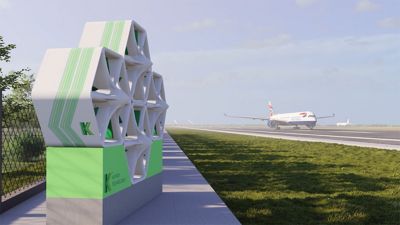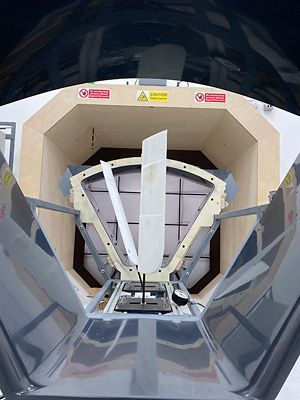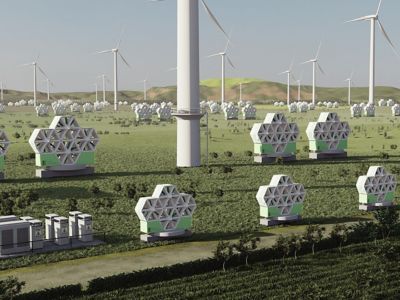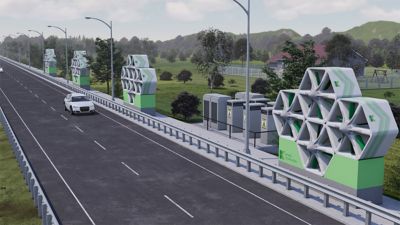-
United States -
United Kingdom -
India -
France -
Deutschland -
Italia -
日本 -
대한민국 -
中国 -
台灣
-
Ansys is committed to setting today's students up for success, by providing free simulation engineering software to students.
-
Ansys is committed to setting today's students up for success, by providing free simulation engineering software to students.
-
Ansys is committed to setting today's students up for success, by providing free simulation engineering software to students.
-
Contact Us -
Careers -
Students and Academic -
For United States and Canada
+1 844.462.6797
ANSYS BLOG
December 28, 2023
Katrick Technologies Advances Wind Energy with Innovative Engineering and Simulation
As environmental concerns about climate change and pollution rise around the world, interest in renewable energy resources also increases. Wind energy is a natural, carbon-free source of renewable energy, but installing wind turbines is not practical in many regions.
Historically, wind turbines operate best in vast, open spaces at high altitudes. While this placement often supports rural communities, it has its limitations in benefiting urban sectors. It’s also a costly investment.
But what if wind energy technology was more affordable and easier to deploy in regions both small and large, in the city and in suburbs? Thanks to an innovation from a Scottish startup, it will be.
Based in Glasgow, Katrick Technologies develops innovative engineering technologies designed to reduce carbon at a lower cost and with more accessibility than traditional methods. As an intellectual property (IP)-based company, Katrick develops technology that is licensed to select global original equipment manufacturers (OEMs) for manufacturing, sales, and distribution. Its main innovations include Wind Panel technology and Passive Cooling systems.
With the help of the Ansys Startup Program, Katrick integrates Ansys multiphysics simulation to advance its Wind Panel technology, which oscillates unlike traditional wind turbines that rotate — a key factor in its accessibility. The technology is still undergoing development, testing, and optimization, with the first live installation expected by late 2024.

At only 2 x 2 m, Katrick’s wind panels can be deployed easily in both rural and urban settings.
Wind Energy on the Go
Katrick’s Wind Panels are small (2 x 2 meters) and effectively capture and convert turbulent ground-level winds into carbon-free electricity through the use of mechanical oscillations. The mechanical oscillations enable the technology to capture low-level turbulent and gusting winds, which are commonly found in urban environments, making the Wind Panels a practical solution for suburbs and cities. Mechanical oscillations are vibrations between two points that move in a back-and-forth motion like a pendulum, spring, or ocean wave.
Rotary wind turbines, which operate in a circular rotation, are better suited to capture winds at altitudes of about 10 meters and above. At this level, wind has a laminar flow and kinetic energy moves smoothly without turbulence. In contrast, wind at ground level is impacted by surrounding conditions, which cause wind gusts and upticks in wind speed.
Katrick’s Wind Panel technology reacts to turbulence with a faster response time thanks to oscillations, aerofoils, and ducts, which help accelerate the velocity of wind inside the panel and effectively increase its power output. Also, the aerofoils have an angular pitch motion that adds to the benefit of the back-and-forth oscillation movement.
Like other renewable energy sources, including traditional wind turbines and solar panels, Katrick’s Wind Panel technology does not use fossil- or carbon-based fuel to produce electrical output. Additionally, due to its design and accessibility, the technology can be placed in regions where wind turbines and solar panels are not practical.

Due to their design, Katrick Technologies’ wind panels can operate at airports without interfering with electronic communication systems or radar.
For example, Katrick’s Wind Panels can be placed on-site at an industrial estate to supply electricity for buildings, from lighting to cooling, heating, and beyond. In another example, they can be placed at an airport to power its terminals, which run on a near-24/7 basis. Due to their mechanics and design, Katrick’s Wind Panels do not interfere with electronic communication systems or radar like rotary turbines. This provides a great opportunity for airports to reduce their carbon footprint, as solar energy is not available in all regions of the world year-round on a daily basis.
Simulating for Speed, Structure, and Sustainability
While Katrick’s innovative ducts and aerofoils have distinct functions, they both help capture kinetic energy from wind. In simple terms, kinetic energy is the energy of motion.
The ducts are designed to channel wind through the panel and internally accelerate the velocity of wind speed. This effect, known as the ducting or venturi effect, can increase wind speed inside the duct by 40%. This enables the technology to harvest more energy as it passes through the duct.
At the same time, multilayered aerofoils work independently from each other to capture kinetic energy from the wind inside the duct and convert this into mechanical energy, which comprises both kinetic energy and potential energy. The powerful mechanical energy is then fed through a system, motor, and generator to produce electricity.
Katrick completed the technology’s first round of testing at the Silverstone Sports Engineering Hub in August and its second round at the University of Strathclyde’s wind tunnel in November. A third round is planned for mid-2024.

Katrick’s wind panel ducts accelerate wind speed and maximize wind energy capture.
Engineers at Katrick benefit from Ansys’ wide range of simulation tools, including Ansys DesignModeler and Ansys SpaceClaim for geometry preparation, Ansys meshing solutions to create computational grids for accurate simulations, and Ansys Fluent to apply computational fluid dynamics (CFD) techniques and simulate airflow around Wind Panels and nearby structures.
“The wind flow, direction, and characteristic data that we collect on-site can be replicated using Ansys simulation to further understand the airflow distribution in and around the Wind Panel device,” says Katrina Calautit, a CFD Engineer at Katrick. “This allows us to further understand where the best place to site our Wind Panel would be, whether between or next to buildings, roofing placements, or near runways.”
DesignModeler and SpaceClaim enable the team to create detailed 3D models and refine computer-aided engineering (CAD) geometry. After the geometry is prepared, team members import the 3D CAD model into an Ansys meshing solution, select an appropriate mesh type, define sizing parameters, and implement boundary layers to capture viscous effects. Once validated, the mesh is exported into Fluent to simulate complex aerodynamic behaviors, airflow distribution, and the effects of wind speed, shear, direction, and shadow.
“In summary, CFD and meshing are essential tools that enable the accurate simulation, analysis, and optimization of fluid flow in the Wind Panel, contributing to the development of more efficient and sustainable renewable energy solutions,” says Calautit. “The tools’ applications extend beyond theoretical simulations, actively contributing to the practical design optimization of the Wind Panel, thus advancing the pursuit of sustainable and effective renewable energy solutions.”
Additionally, Fluent’s post-processing capabilities enable additional visualization of flow variables through contour plots, vectors, and streamlines, providing a comprehensive understanding of fluid behavior.
“The comprehensive Ansys simulation workflow allows us to gain insights into the system’s performance, validate against experimental data, and make informed design decisions for the efficient and sustainable development of our Wind Panel technology,” she adds.

An Ansys Fluent simulation depicts the wind direction and flow around a built environment in Glasgow.

An analysis in Ansys Fluent illustrates the wind velocity around buildings in Glasgow.
Starting up Success
Katrick Technologies was established in 2016, but development of its Wind Panel technology began in 2020 when graduate students at Glasgow Caledonian University initiated early designs during a final project. After graduation, the students brought their ideas to Katrick and joined the team as full-time engineers in 2021. Development advanced further with support from the Manufacturing Technology Centre, a U.K.-based independent research and technology organization (RTO), and Ansys.

Katrick Technologies’ Wind Panel technology is undergoing development, testing, and optimization, with a commercial model expected by mid- to late-2024.
Engineering consultancy firm Wilde Analysis Ltd, a PDS Vision Group company and an Ansys Select Channel Partner, introduced Katrick to the Ansys Startup Program, which supports early- to mid-stage startups by offering affordable access to Ansys’ simulation solutions.
“Without Ansys, we would not have been able to validate the results from our wind tunnel testing, enhance the design of our duct for increased wind speeds and power capture, or understand the airflow distribution for placement of our technology across various site locations,” says Alexandra Basso, Marketing Manager at Katrick Technologies. “Without this, we would be months behind in development and further away from commercial discussions with potential OEMs.”

Katrick Technologies is dedicated to the development of clean technology and accelerating the transition to renewable energy through innovation.
Katrick is on track to complete its first live installation by 2024, but the company isn’t stopping there. Dedicated to the development of clean technologies, Katrick envisions a cleaner future and plans to use Ansys simulation while designing the technology to make it happen.
“At Katrick Technologies, our mission is to accelerate the transition to renewable energy through innovation,” she says. “We have a suite of technologies to come to market utilizing waste heat, wave, and vibrations. As part of the journey to create, design, and develop these technologies, Ansys simulation will be critical in understanding how our technologies will operate and benefit across various environments by validating testing, enhancing product development and performance, and simulating optimization variables of the technology itself.”
Learn more about the Ansys Startup Program, view eligibility requirements, software bundles, and success stories.
See What Ansys Can Do For You
See What Ansys Can Do For You
Contact us today
Thank you for reaching out!
We’re here to answer your questions and look forward to speaking with you. A member of our Ansys sales team will contact you shortly.











